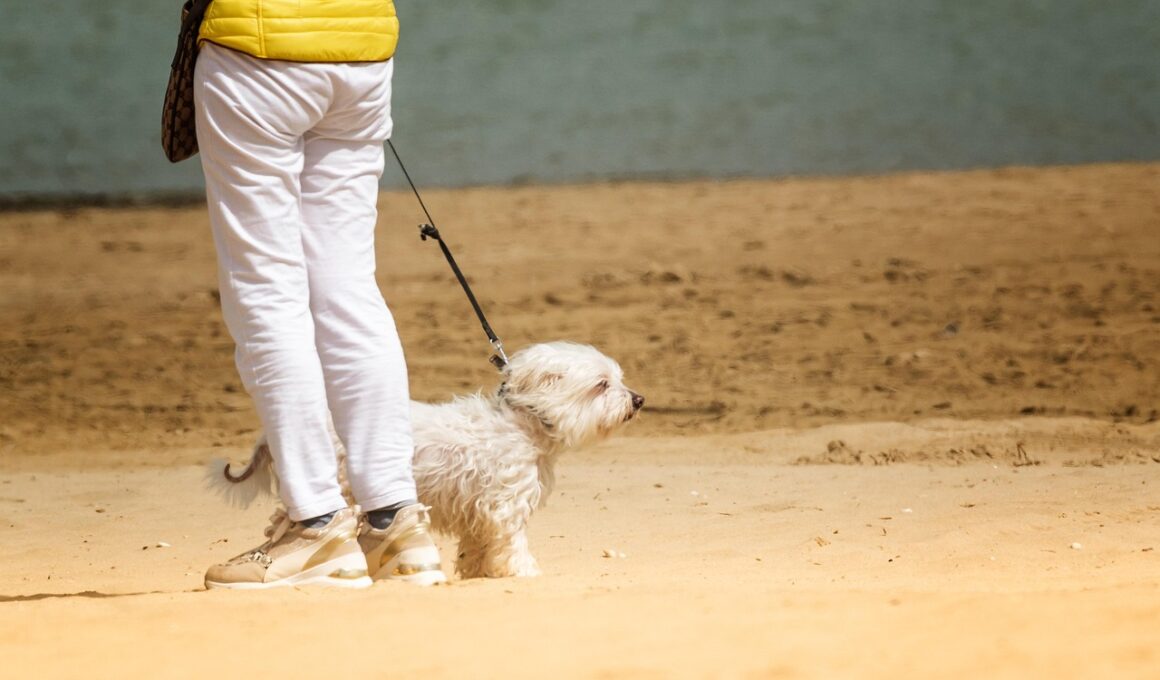Essential Safety Tips for Exercising Your Dog Outdoors
When it comes to exercising your dog outdoors, safety is paramount. Understanding how to effectively prepare can make a significant difference. Always check the weather forecast to avoid extreme temperatures that could harm your dog. During summer months, early morning or late evening walks can help reduce heat exposure. Make sure to carry plenty of fresh water for your dog, especially on long walks. Hydration is essential for keeping your furry friend healthy and energetic. Invest in a comfortable, secure harness rather than a standard collar, as it will provide better control and prevent injury. Never let your dog off-leash in unfamiliar areas, as the risk of injury or escape increases significantly. Supervision is key, especially in public spaces where other dogs might be present. Additionally, ensure your dog is up to date on vaccinations before routine trips to parks. Maintain a first-aid kit on hand that includes dog-specific items like gauze, antiseptic wipes, and any prescribed medication. Lastly, familiarize yourself with your dog’s breed-specific health risks to ensure a safe outdoor experience. Every dog is unique, and tailored care is fundamental.
Another important aspect to consider is the terrain you and your dog will be exercising on. Rocky, uneven ground can result in injuries such as cuts or sprains. Choose trails that match your dog’s physical capabilities and experience level. Avoid allowing your dog to engage in strenuous activities suddenly; gradually increase the intensity and duration of your walks or jogs. Start with shorter distances and monitor how your dog responds. Look for signs of fatigue or discomfort, and be prepared to adjust your plans accordingly. For dogs with existing joint issues or senior dogs, consult with a veterinarian for personalized exercise recommendations. It is also wise to research dog-friendly locations. Many parks and hiking spots have designated areas for canines. Ensure they are safe, clean, and provide sufficient shade for breaks. Engaging in social interactions with other dogs can be beneficial but always supervise playtime to prevent potential scuffles. Remember to respect leash laws in public areas. Not only does this protect your dog’s safety, but it also safeguards the well-being of others. A well-exercised dog is a happy dog, contributing to their overall happiness.
Be Mindful of Your Dog’s Limits
Paying close attention to your dog’s energy levels is incredibly important during outdoor exercise. This means observing how your dog behaves and responds can help you gauge whether to continue or take a break. Dogs can be eager to please their owners, so they might push themselves beyond their physical limits, leading to injuries. Engage in regular training sessions to build your dog’s stamina progressively. Incorporate fun activities like fetch, agility drills, or chasing a frisbee into your routine to keep them engaged while exercising. Offering both mental and physical stimulation goes a long way in ensuring their well-being. In addition, consider the importance of their paw health. Dogs can get paw injuries from walking over rough or hot surfaces. Always check your dog’s paws for cuts, abrasions, or heat damage after outdoor exercising. Even taking walks on concrete can pose risks to sensitive paws during high temperatures. Invest in protective gear like dog booties if your dog has sensitive paws, especially for long hikes among rocky terrains. Maintaining your dog’s comfort and safety should be your top priority.
Nutrition also plays a crucial role in your dog’s overall health, especially when engaging in outdoor activities. Ensure your dog is eating a balanced diet suitable for their age, breed, and activity level. Consult with your veterinarian to determine the right food and feeding schedule. Consider having post-exercise snacks available for them, and provide fresh water right after their workout sessions. This replenishes lost electrolytes and prevents dehydration. Monitoring your dog’s weight is also vital, as obesity can limit their ability to exercise and adversely affect their joints. Establish a regular feeding and exercise routine that fits both your and your dog’s lifestyle. Use it to foster discipline and structure. Furthermore, ensure that your dog has identification tags accompanying their collar. This can help significantly in the event they get loose or lost during exercise. An up-to-date microchip can also serve as an additional measure for safety. As a responsible pet owner, you carry the responsibility of their welfare outdoors. An adequately informed approach ensures a healthier, more enjoyable experience for both of you during your outdoor adventures.
Keep an Eye on Your Dog’s Behavior
Always be cognizant of your dog’s behavior during outdoor activities. Pay special attention to any sudden changes in their temperament or energy levels. Nervous behaviors might indicate they feel overwhelmed or scared. If your dog appears anxious or agitated, it’s advisable to cut your outing short. Sometimes other dogs, crowds, or environmental factors can trigger fears, so be aware of signs like frequent barking, whining, or attempts to hide. Providing a safe environment while exercising is essential for your dog’s enjoyment. Keep the area around you secure and remove avoidable distractions that could cause stress or anxiety during your excursions. Also, set boundaries for how far you allow them to stray while on a leash to prevent any unexpected encounters. Having consistent commands and training helps reinforce boundaries while out. Training sessions in a controlled environment can also boost their confidence, preparing them for any outdoor encounters. Engaging in socialization activities helps build resilience in different environments while promoting a more relaxed nature overall. Continued learning, social interaction, and discipline will create a safe, enjoyable space for outdoor exercising.
Additionally, choose the right time for your dog’s walks to enhance their outdoor experience. Mornings and evenings are typically safer and cooler for outdoor activities in hot weather. Not only does it reduce heat exposure, but it also minimizes the risk of overheated pavements injuring your dog’s paws. Monitor your dog for signs of exhaustion, and take plenty of breaks as necessary. When heading out, be aware of any local wildlife, especially in rural areas where snakes, insects, or ticks are prevalent. These creatures can pose risks to your dog’s safety. Consult with your veterinarian about preventative medications for ticks and fleas. Keeping your dog on a leash will help avoid potential encounters with wildlife, ensuring their safety. Having a pair of pooper scoopers available ensures that you are respecting nature and keeping the environment clean. This is especially important in public parks. Always adhere to park rules regarding dog behavior and waste clean-up. Educating yourself about any local regulations helps not just your experience but contributes positively to the pet community at large. Keeping your dog safe while they exercise is vital.
Conclusion: Prioritize Dog Safety Outdoors
In summary, dog safety during outdoor exercise involves comprehensive planning and awareness. Always consider the weather and choose appropriate times for physical activities. Understanding your dog’s limits while gradually increasing exercise intensity helps prevent injuries and ensures their enjoyment. Keeping hydrated, both on long walks and immediately after, is key to maintaining your dog’s well-being. It’s imperative to stay informed about local regulations and dog-friendly places to maximize safety. Be proactive in addressing any behavioral or health issues your dog may display. Effective communication between you and your dog promotes a satisfying partnership during activities. Additionally, investing in safety gear, such as harnesses and booties, provides extra security on various terrains. Regular vet check-ups and specialized nutrition reinforce a proactive approach to your dog’s health. Engaging in targeted training sessions enhances their ability to cope in different environments, fostering confidence. Every effort you make contributes significantly to a safer and overall positive experience. Making each outdoor adventure enjoyable yet safe ensures a long-lasting bond between you and your canine friend. Following these simple guidelines will lead to many memorable moments.
Remember, creating safe outdoor experiences for your dog is an ongoing endeavor. With the right strategies and knowledge, you can enjoy countless happy adventures together while prioritizing your furry friend’s health and safety. Always be aware that responsibility goes hand-in-hand with pleasure in dog ownership. Make use of the tips and suggestions outlined above to ensure your outings are filled with joy and excitement. Each step taken toward enhancing your dog’s outdoor safety will lead to a more enjoyable time for both of you. Ultimately, fostering a safe environment creates reassurance in both you and your dog. Keep exploring and enjoying the wonders of nature together!


